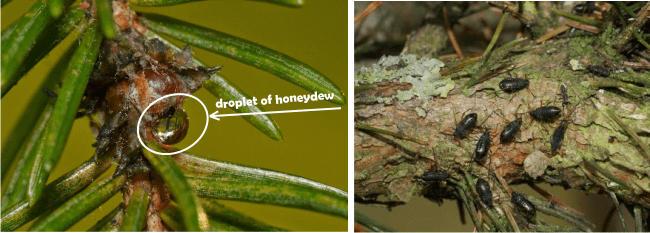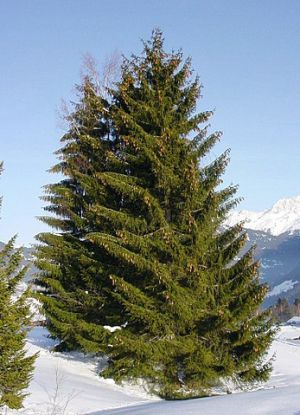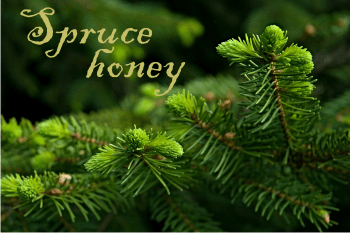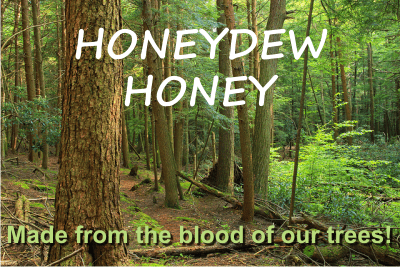Does a spruce have flowers? What is spruce honey then?
A special type of honey belonging to the category of honeydew honeys, made not from the nectar harvested from flowers but from the droplets of honeydew that honey bees find on the tree bark. In countries like Germany, Switzerland, Austria, Sweden, Romania and Slovenia, honeydew honey is beloved by consumers.
Honeydew honeys can be classified according to the type of insects that produce the honeydew and according to the tree source.
– In the first category we have honeydew produced by aphid Metalfa pruinosa (see What is metcalfa honey?) and then all the other aphids, adelgids and scales (Persano and Piro, 2004).
– In the second category we have honeydew honey produced from trees (coniferous and latifoliae) such as fir, pine, spruce, oak-tree or combinations of them. We can find them labeled according to their source eg. “pine honey”, “French oak-tree honey”, “fir honey”, but most often we find them marketed as “forest honey”, often mixed with honeydew honeys from other coniferous trees (in central Europe).
What produces honeydew on spruce?
Some little insects called adelgids and aphids. Pests, as they infect the tree and feed from its sap. One of the reasons honeydew honey is organic is that there are no pesticides used, on the contrary, the entire honey is made from the sweet droplets pests secrete (secrete – as in what they poop after eating the tree’s sap.)
Aphids: Blackman & Eastop list about 170 species of aphids as feeding on spruces (Picea) worldwide, but the most comon are Cinara pilicornis, Cinara costata, Cinara piceae and Physokermes hemicryphus.
Cinara pilicornis is found on Norway spruce (Picea abies) and Sitka spruce (Picea sitchensis). It is a quite large aphid species that seems to have little effect on the tree. Although it is a European species it has also been reported in spruce forests in New Zealand, together with the spruce aphid Elatobium abietinum.
 Droplet of honeydew -picture source abundantnature.com; Cinara piceae aphid on spruce – picture source Enlil2
Droplet of honeydew -picture source abundantnature.com; Cinara piceae aphid on spruce – picture source Enlil2
Adelgids are similar, in some ways, to aphids, but they’re mostly immobile (like scales), have different life cycle details and body structures, and are associated with conifers. Adelgids insert long stylets into the host tree and feed on the sap during the entire stationary part of its life cycle. Spruce gall adelgids cause those horny growths, resembling cones, on spruce, particularly blue spruce.
If you want to know more details about how honey bees produce this honey, please read What is honeydew honey? or What is metcalfa honey?

The spruce
A spruce is an evergreen tree of the genus Picea, which has 35 species in the family Pinaceae. It is found in the northern temperate and boreal (taiga) regions of the Earth.
The most common is known as our Christmas Tree, Picea abies, or the Norway spruce, native to Northern, Central and Eastern Europe. In North America, other species are common, like Picea breweriana or Picea sitchensis, the Sitka spruce.
It is said that the world’s oldest living tree is a Norway spruce clone named Old Tjikko, carbon dated as 9,550 years old!
How is spruce honey
Spruce honey is made from Picea abies tree. It is mainly produced in Europe, Norway, Slovenia, Czech, Poland, Italy (mostly from the Alps area) and Northern Greece (It is estimated that about 5-10% of the honey produced in Greece is made from spruce).
It is one of the best honeys we have and pretty expensive, too.
Color: amber color from light to dark, sometimes with reddish veins.
Smell: gently of resin
Aroma: not very intense,of smoke, caramel, condensed milk, cooked, malted, panna cotta, resinous, a little balsamic
Taste: medium intensity, slightly sweet and persistent.
Crystallization: slow, in 1.5 – 2 years.
Glucose level: low
Antioxidant level: high.
Minerals level: high. it is rich in potassium, magnesium, phosphorus, iron.
Health benefits of spruce honey
Folk medicine says spruce honey helps in treating upper respiratory problems, especially cough and bronchitis. There are not (yet) scientific studies to support this claim, yet, tradition and experience have always been teaching us how to treat ourselves, way ahead science.
The studies we have by now are more focused on a general honeydew honey, not particularly on spruce honey.
Other medical recommendations: anemia (due to its rich content of minerals), constipation, as antioxidant, antibacterial and anti-inflammatory agent.
Spruce is so good for respiratory issues, that people are making other types of syrups from it.
Spruce syrup
Spruce syrup is not spruce honey.
There are 2 types of spruce syrup.
1. Spruce syrup made in spring from the new bright young tips that grow appear on the spruce trees. Here is the recipe:
– 8 cups (or 2 liters) of water
– 2 cup (500 ml) young spruce needle tips (or pine needles)
– 2 cups (500 ml) sugar
Put the water into a large stainless steel saucepan and bring it to boil. Add the spruce tips into the water and simmer on a low heat for half an hour in the covered pan. Then switch off the heat and let it steep for 2 to 3 hours. Then filter off the needles.
This stained water has to be put back on the stove and simmer for another hour till the water is reduced to half (almost 2 cups). Remove from the heat.
For each cup of liquid add ½ cup of sugar. Bring to boil and boil rapidly for 5 minutes. Pour into sterilized bottles and cap. Keep it in dark cold place, do not refrigerate (no need).
2. Spruce syrup made from a regular honey infused with fresh spruce tips. This syrup is recommended for sore throats, laryngitis, pharyngitis, colds, and all disorders associated with the upper respiratory system.
You can do this type of syrup at home, or simply buy it.
Here is an example of spruce syrup with cough breaking-up effect – as the producer says: Spruce Tips, syrup, 150 ml.
 Where can we find real spruce honey?
Where can we find real spruce honey?
• Epirusfarm.com sells Greek spruce honey at prices up to €8.
• Medeni.si sells Slovenian spruce honey – a jar of 450g at €6.50.
• On Amazon.com I found a Greek spruce honey combined with chestnut honey. A real bomb of nutritional and health benefits under the same roof: a sweet delicious honey.
Here: Macrovita Chestnut Spruce Honey. 400gr from Apivita.
• Or you can find spruce honey under the name “forest honey”. Here is an example from Sweden: Organic Honeydew honey 250g.
=====
=====
References:
http://msue.anr.msu.edu/news/honeydew
https://en.wikipedia.org/wiki/Spruce
https://en.wikipedia.org/wiki/Picea_abies






